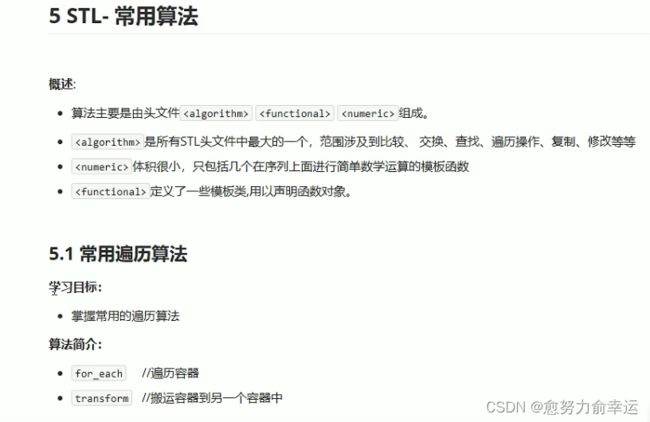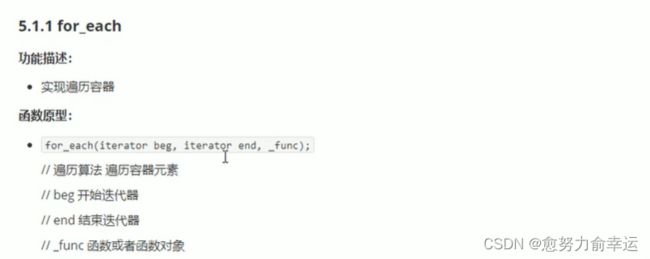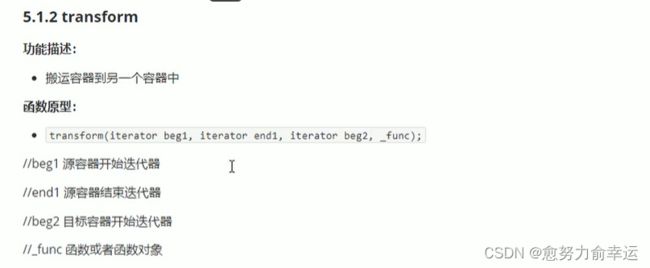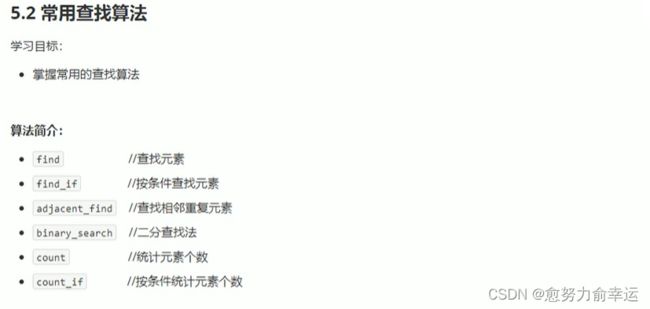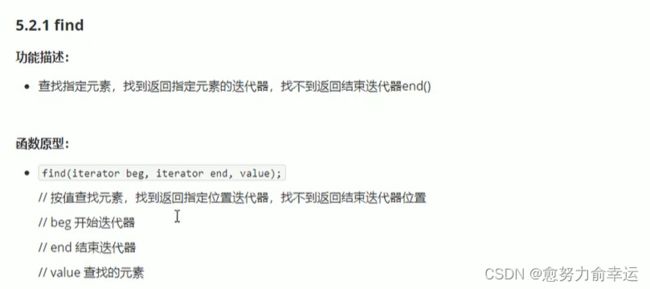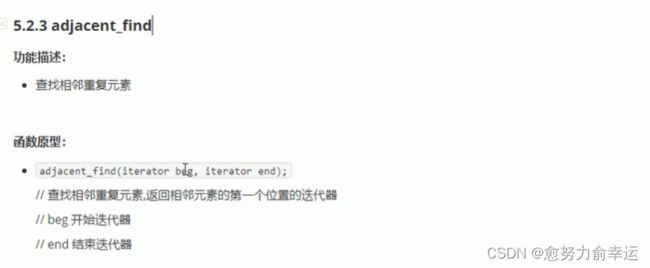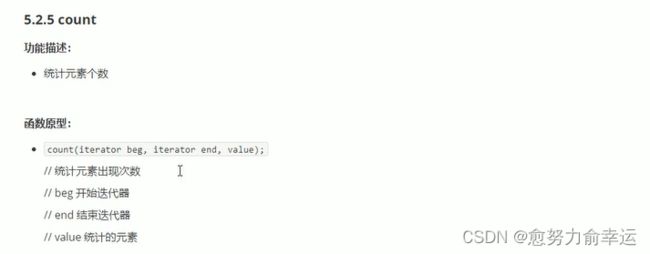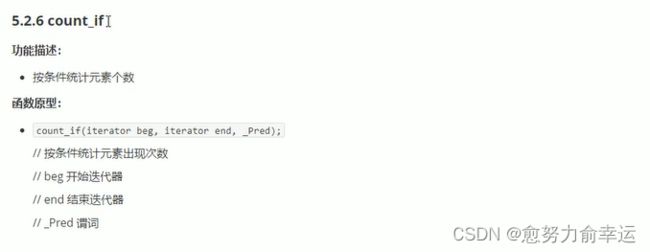STL常用遍历,查找,算法
目录
1.遍历算法
1.1for_earch
1.2transform
2.常用查找算法
2.1find,返回值是迭代器
2.1.1查找内置数据类型
2.1.2查找自定义数据类型
2.2fin_if 按条件查找元素
2.2.1查找内置的数据类型
2.2.2查找内置数据类型
2.3查找相邻元素adjeacent_find
2.4查找指定元素是否存在binarary_search
2.5统计元素的个数count
2.5.1统计内置数据类型
2.5.2统计自定义数据类型
2.6按条件统计元素个数
2.6.1统计内置数据类型
2.6.2统计自定义的数据类型
3.常用排序算法
3.1sort
1.遍历算法
1.1for_earch
#include
using namespace std;
#include
#include
//常用遍历算法 for_each
//利用普通函数实现
void print01(int val)
{
cout << val << " ";
}
//仿函数(函数对象)本身是个类。不是一个函数
class print02
{
public:
void operator()(int val)
{
cout << val << " ";
}
};
void test01()
{
vectorv;
for (int i = 0; i < 10; i++)
{
v.push_back(i);
}
for_each(v.begin(), v.end(), print01);//第三个位置,普通函数是把函数名放过来
cout << endl;
for_each(v.begin(), v.end(), print02());//第三个位置需要传入函数对象
//类名加小括号,创建出匿名对象
}
int main()
{
test01();
system("pause");
return 0;
}
1.2transform
#include
using namespace std;
#include
#include
//常用遍历算法 transform
//仿函数(函数对象)本身是个类。不是一个函数
class Transform
{
public:
//搬运过程中把每个元素取出来在返回回去,由于操作的是int型,所以返回int
int operator()(int val)
{
return val+100;//+100在搬到容器中
}
};
class Myprint
{
public:
void operator()(int val)
{
cout << val << " ";
}
};
void test01()
{
vectorv;
for (int i = 0; i < 10; i++)
{
v.push_back(i);
}
vectorvTarget;//目标容器
vTarget.resize(v.size());//目标容器 需要提前开辟空间,不然报错
transform(v.begin(), v.end(), vTarget.begin(), Transform());//最后一个位置函数对象
for_each(vTarget.begin(), vTarget.end(), Myprint());//最后一个位置函数对象
cout << endl;
}
int main()
{
test01();
system("pause");
return 0;
}
2.常用查找算法
2.1find,返回值是迭代器
2.1.1查找内置数据类型
#include
using namespace std;
#include
#include
#include
//常用查找算法
//find
//查找 内置数据类型
void test01()
{
vectorv;
for (int i = 0; i < 10; i++)
{
v.push_back(i);
}
//查找 容器中 是否有 5 这个元素
vector::iterator it = find(v.begin(), v.end(), 50);
if (it == v.end())
{
cout << "没有找到!" << endl;
}
else
{
cout << "找到:" << *it << endl;
}
}
int main()
{
test01();
system("pause");
return 0;
}
2.1.2查找自定义数据类型
#include
using namespace std;
#include
#include
#include
//常用查找算法
//find
class Person
{
public:
Person(string name, int age)
{
m_Name = name;
this->m_Age = age;
}
//重载== 让底层find知道如何对比person数据类型
bool operator ==(const Person& p)//const防止修改p
{
if (this->m_Name == p.m_Name && this->m_Age == p.m_Age)
{
return true;
}
else
{
return false;
}
}
string m_Name;
int m_Age;
};
//查找 自定义数据类型
void test02()
{
vectorv;
//创建数据
Person p1("aaa", 10);
Person p2("bbb", 20);
Person p3("ccc", 30);
Person p4("ddd", 40);
//放到容器中
v.push_back(p1);
v.push_back(p2);
v.push_back(p3);
v.push_back(p4);
Person p("bbb", 20);
//查找是否有和p一样的
vector::iterator it = find(v.begin(), v.end(), p);
if (it == v.end())
{
cout << "没有找到" << endl;
}
else
{
cout << "找到元素:姓名:" << (*it).m_Name << " 年龄:" << it->m_Age << endl;
}
}
int main()
{
test02();
system("pause");
return 0;
}
2.2fin_if 按条件查找元素
2.2.1查找内置的数据类型
#include
using namespace std;
#include
#include
#include
//常用查找算法
//find_if
//1.查找内置数据类型
class GreaterFive
{
public://谓词返回bool
bool operator()(int val)//find_if的底层也是取出每个元素并解引用,放到重载小括号里去操纵
{
return val > 5;//大于5 的时候就返回真
}
};
void test01()
{
vectorv;
for (int i = 0; i < 10; i++)
{
v.push_back(i);
}
//返回一个迭代器
vector::iterator it=find_if(v.begin(), v.end(), GreaterFive());//第三个位置是匿名函数对象
if (it == v.end())
{
cout << "没有找到大于5的元素" << endl;
}
else
{
cout << "找到大于5的数字为:" << *it << endl;
}
}
//2.查找自定义数据类型
int main()
{
test01();
system("pause");
return 0;
}
2.2.2查找内置数据类型
#include
using namespace std;
#include
#include
#include
//常用查找算法
//find_if
//2.查找自定义数据类型
class Person
{
public:
Person(string name, int age)
{
m_Name = name;
this->m_Age = age;
}
string m_Name;
int m_Age;
};
class Great20
{
public:
bool operator()(Person &p)//每个数据类型都是Perosn的数据类型用引用的方式传进来
{
return p.m_Age > 20;
}
};
bool G2(Person& p)
{
return p.m_Age > 20;
}
void test02()
{
vectorv;
//创建数据
Person p1("aaa", 10);
Person p2("bbb", 20);
Person p3("ccc", 30);
Person p4("ddd", 40);
v.push_back(p1);
v.push_back(p2);
v.push_back(p3);
v.push_back(p4);
//找年龄大于20的人
vector::iterator it = find_if(v.begin(), v.end(), Great20());
if (it == v.end())
{
cout << "没有找到" << endl;
}
else
{
cout << "找到姓名:" << (*it).m_Name << "年龄:" << it->m_Age << endl;
}
vector::iterator it1 = find_if(v.begin(), v.end(), Great20());
if (it1 == v.end())
{
cout << "没有找到" << endl;
}
else
{
cout << "找到姓名:" << (*it1).m_Name << "年龄:" << it1->m_Age << endl;
}
}
int main()
{
test02();
system("pause");
return 0;
}
2.3查找相邻元素adjeacent_find
#include
using namespace std;
#include
#include
//常用查找算法
//adjacent_find
void test01()
{
vectorv;
v.push_back(0);
v.push_back(2);
v.push_back(0);
v.push_back(3);
v.push_back(1);
v.push_back(4);
v.push_back(3);
v.push_back(3);
vector::iterator it=adjacent_find(v.begin(), v.end());
if (it == v.end())
{
cout << "未找到相邻重复元素" << endl;
}
else
{
cout << "找到相邻重复元素:" << *it << endl;
}
}
int main()
{
test01();
system("pause");
return 0;
}
2.4查找指定元素是否存在binarary_search
#include
using namespace std;
#include
#include
//常用查找算法
//binary_search 二分查找法,在无序的序列中不可以用
void test01()
{
vectorv;
for (int i = 0; i < 10; i++)
{
v.push_back(i);
}
//查找容器中是否有9
//注意容器必须是有序的序列
//如果无序结果未知
bool ret = binary_search(v.begin(), v.end(), 9);
if (ret)
{
cout << "找到了元素" << endl;
}
else
{
cout << "没找到" << endl;
}
}
int main()
{
test01();
system("pause");
return 0;
}
2.5统计元素的个数count
2.5.1统计内置数据类型
#include
using namespace std;
#include
#include
//常用查找算法
//count
//1.统计内置数据类型
void test01()
{
vectorv;
v.push_back(10);
v.push_back(40);
v.push_back(30);
v.push_back(40);
v.push_back(20);
v.push_back(40);
int num=count(v.begin(), v.end(), 40);
cout << "40的元素个数为:" <
2.5.2统计自定义数据类型
#include
using namespace std;
#include
#include
//常用查找算法
//count
//2.统计自定义数据类型
class Person
{
public:
Person(string name, int age)
{
m_Name = name;
this->m_Age = age;
}
bool operator==(const Person& p)//底层要加const,
{
if (m_Age==p.m_Age)
{
return true;
}
else
{
return false;
}
}
string m_Name;
int m_Age;
};
void test02()
{
vectorv;
Person p1("刘备", 35);
Person p2("关羽", 35);
Person p3("张飞", 35);
Person p4("赵云", 30);
Person p5("曹操", 40);
//将人员插入到容器中
v.push_back(p1);
v.push_back(p2);
v.push_back(p3);
v.push_back(p4);
v.push_back(p5);
Person p("诸葛亮", 35);
//统计与诸葛亮年龄相同的有几人
int num = count(v.begin(), v.end(), p);
cout << "和诸葛亮同岁数的人员个数为:" << num << endl;
}
int main()
{
test02();
system("pause");
return 0;
}
2.6按条件统计元素个数
2.6.1统计内置数据类型
#include
using namespace std;
#include
#include
//常用查找算法
//count_if
//1.统计内置数据类型
class Greater20
{
public:
bool operator()(int val)
{
return val > 20;
}
};
void test01()
{
vectorv;
v.push_back(10);
v.push_back(40);
v.push_back(30);
v.push_back(20);
v.push_back(40);
v.push_back(20);
int num = count_if(v.begin(), v.end(), Greater20());
cout << "大于20的元素个数为:" << num << endl;
}
int main()
{
test01();
system("pause");
return 0;
}
2.6.2统计自定义的数据类型
#include
using namespace std;
#include
#include
//常用查找算法
//count_if
//2.统计自定义的数据类型
class Person
{
public:
Person(string name, int age)
{
m_Name = name;
this->m_Age = age;
}
string m_Name;
int m_Age;
};
class AgeGreater20
{
public:
bool operator()(Person &p)
{
return p.m_Age > 20;
}
};
void test02()
{
vectorv;
Person p1("刘备", 35);
Person p2("关羽", 35);
Person p3("张飞", 35);
Person p4("赵云", 40);
Person p5("曹操", 20);
v.push_back(p1);
v.push_back(p2);
v.push_back(p3);
v.push_back(p4);
v.push_back(p5);
//统计 大于20岁人员个数
int num = count_if(v.begin(), v.end(), AgeGreater20());
cout << "大于20的元素个数为:" << num << endl;
}
int main()
{
test02();
system("pause");
return 0;
}
3.常用排序算法
3.1sort
#include
using namespace std;
#include
#include
//常用排序算法
//sort
void myPrint(int val)
{
cout << val << " ";
}
void test01()
{
vectorv;
v.push_back(10);
v.push_back(30);
v.push_back(50);
v.push_back(20);
v.push_back(40);
//利用sort进行升序,默认情况下升序
sort(v.begin(), v.end());
for_each(v.begin(), v.end(), myPrint);
cout << endl;
//改变为降序
sort(v.begin(), v.end(), greater());//greater()内建函数对象,需要包含functional头文件,编译器高的不包含functional头文件也不会出错
for (int i = 0; i < v.size(); i++)
{
cout << v[i] << " ";
}
cout << endl;
}
int main()
{
test01();
system("pause");
return 0;
}
bool compare(int a,int b)
{
return a < b; //升序排列,如果改为return a>b,则为降序
}
int a[20]={2,4,1,23,5,76,0,43,24,65},i;
for(i=0;i<20;i++)
cout<< a[i]<< endl;
sort(a,a+20,compare);
#include
using namespace std;
#include
#include
#include
#include
#include
#include
#include
